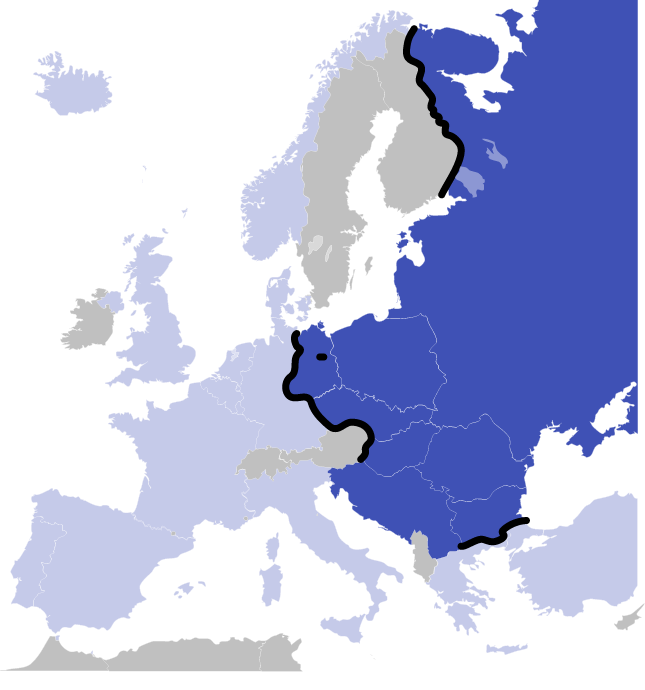OVERVIEW
01
THE BIG THREE
AT YALTA
The 1945 Yalta conference shapes the post-war landscape by setting in place Soviet and Western spheres of influence.
READ THIS PART
02
THE IRON CURTAIN DESCENDS:
EAST vs. WEST
The Iron Curtain symbolises the political separation between Western Europe and the Soviet-influenced communist countries of Eastern Europe.
READ THIS PART
03
THE UNITED STATES AID PROGRAMME
TO WESTERN EUROPE
The United States undertakes the Marshall Plan, an initiative to aid western Europe and help rebuild Western European economies.
READ THIS PART

THE BIG PICTURE: THE MAKING AND BREAKING OF EUROPE
01
The Big Three at Yalta
>
In the grounds of the Livadia Palace, Yalta, during the Three Power Conference the British wartime Prime Minister Sir Winston Churchill, the 32nd President of the USA Franklin Roosevelt and the Soviet leader Joseph Stalin | PHOTO BY KEYSTONE/GETTY IMAGES
“Essentially, Yalta shapes the postwar landscape”
FOCUS
RICHARD ALDRICH
Europe, divided by nationalism and devastated by war, was to have a new beginning, and it would be ordained by the leaders of Britain, the US and the Soviet Union in the Crimean resort of Yalta.
In February 1945, US President Franklin D Roosevelt, British Prime Minister Winston Churchill and Soviet Premier Joseph Stalin marked out a joint plan for a liberated Europe.
It set in place spheres of influence for Soviet and Western interests, and would lead to the creation of East and West Germany.
THE END OF WORLD WAR II
*
World War II (1939-1945) involved 61 countries with 1.7 billion people (3/4 of the world's population).
vs.
AXIS
Germany, Italy, Japan, Hungary, Romania, Bulgaria
ALLIES
US, Britain, France, USSR, Australia, Belgium, Brazil, Canada, China, Denmark, Greece, Netherlands, New Zealand, Norway, Poland, South Africa, Yugoslavia
*
Estimated 50-85 million people lost their lives - making it the deadliest conflict in human history.
click to expand
>
American President Franklin Roosevelt , right, with Admiral William D. Leahy and General George C. Marshall at the conference in Yalta, in the Crimea. | PHOTO BY KEYSTONE/GETTY IMAGES
Yalta newsreel
ARCHIVE
INTERVIEW
“One of the first to be greeted at the Yalta airfield by the … Mr Churchill arrives direct from Malta. The Kremlin guards form a guard of honour and march past in full army style … etc”
“Essentially, Yalta shapes the postwar landscape that we see all the way from 1945 to 1989, including the positioning of the Iron Curtain. The fate of the East European countries was controversial.
On the one hand, many people felt Russia had a case for some sort of security interest in the East, because, of course, Russia had suffered so badly at the hands of Germany.
But at the same time, the language of the Yalta Conference seemed to guarantee a degree of democracy and pluralism, and when that doesn’t happen, there’s a sense of those promises about pluralism being shut down.”
Richard Aldrich
WATCH
NEWSREEL
“Mr Churchill arrives direct from Malta. The Kremlin guards form a guard of honour and march past in full army style.”
Yalta newsreel



American President Franklin Roosevelt in a jeep after arriving at Yalta airport for the Big Three Conference. Also in the photograph are British Prime Minister Winston Churchill and Soviet Foreign Minister Vyacheslav Molotov. | PHOTO BY KEYSTONE FEATURES/GETTY IMAGES
Winston Churchill takes a new cigar as Joseph Stalin smiles with approval at the Crimea conference, Yalta | PHOTO BY KEYSTONE/GETTY IMAGES
Franklin Roosevelt (left), and the British wartime Prime Minister Sir Winston Churchill (right), at the Yalta Conference. | PHOTO BY KEYSTONE/GETTY IMAGES
1 - 3
<
>
Q&A
WHY WAS THE MEETING IN YALTA SO IMPORTANT?
*
*
It was the second wartime meeting between the ‘Big Three’ - British prime minister Winston Churchill, Soviet premier Joseph Stalin, and President Franklin D Roosevelt.
During the conference, the three leaders started plans that ultimately shaped the post war landscape of Europe, including the eventual positioning of the Iron Curtain.
click to expand
Q&A
WHAT WERE THE KEY AGREEMENTS?
01
Germany was required to unconditionally surrender, demilitarise and pay reparations.
02
The country would also be temporarily broken into 4 zones, each occupied by a different power: United Kingdom, United States, the Soviet Union and France.
03
Provisional governments would be established in every ‘liberated’ country. These governments would be supported in rebuilding their countries and, through democratic elections, choosing their own governments.
click to expand
But Yalta went beyond allocating the spoils of war. It ushered in the beginning of a new grand narrative.
02
Iron Curtain descends: East vs. West
>
The speech by Sir Winston Churchill to the Westminster High School Of Fulton (Missouri) in the presence of the US President Truman remains famous for the denouncing of the Iron Curtain. on March 5, 1946. | PHOTO BY KEYSTONE-FRANCE/GAMMA-KEYSTONE VIA GETTY IMAGES
“Stalin’s primary concern was security”
DAN STONE
INTERVIEW
“Stalin’s primary concern was what he called security. It was quite clear that the countries that the Red Army occupied would remain part of the Soviet sphere. And the Americans and the British started to become more suspicious of Soviet motives and to see Soviet aggression as something that they needed to deal with much more.”
Dan Stone
WATCH
ARCHIVE
"From Stettin in the Baltic to Trieste in the Adriatic, an iron curtain has descended across the Continent..”
Winston Churchill
EASTERN BLOC
WESTERN BLOC
IRON CURTAIN
COLD WAR
The Iron Curtain became a political, military, and ideological barrier erected by the Soviet Union to seal itself and its satellite states from open contact with the West and non-Soviet-controlled areas.
British Prime Minister Winston Churchill’s famous 1946 address - which is sometimes referred to as the “Iron Curtain Speech” - is regarded as marking the commencement of the Cold War between the democratic Western world and the communist Eastern bloc with the Soviet Union as its political centre.

03
The US aid programme to Western Europe
>
US President Truman signs the Economic Assistance Act, a programme for the reconstruction of Europe. | PHOTO BY PHOTO12/UIG VIA GETTY IMAGES
“Essentially it’s about making Western Europe
in America’s own image”
RICHARD ALDRICH
If the US was to challenge any Soviet aggression, then to American minds, a unified Western European bloc would be a vital bulwark.
MARSHALL PLAN ARTWORK




1 - 4
<
>
INTERVIEW
“Europe was left completely economically dilapidated, struggling, and at that time, you know, if we think of where is the starting point for what we now call the European Union, in many ways it was the Marshall Plan.”
Alina Polyakova
WATCH
Q&A
WHAT WAS THE MARSHALL PLAN?
01
The Marshall Plan was an American initiative to aid Europe after the end of World War II. Funds were initially offered to Soviet Bloc countries as well, but were rejected by Stalin.
02
The United States gave over $13 billion in economic support to rebuild Western European economies.
03
The plan was in operation for 4 years beginning April 8, 1948.
click to expand
Q&A
One of a number of posters created to promote internationalism and cooperation through the Marshall Plan in Europe. Note the pivotal position of the American flag in poster 1.
WHAT WERE THE GOALS OF THE INITIATIVE?
*
The Marshall Plan had two interrelated goals:
01
1. ECONOMY
- to rebuild war-devastated regions across Western Europe
- remove trade barriers and modernise industry
02
2. IDEOLOGICAL
discourage the spread of Communism
click to expand
1948-49
1949-50
1950-51
1948-49
1949-50
1950-51
1948-49
1949-50
1950-51
1948-49
1949-50
1950-51
$232m
$166m
$70m
$195m
$222m
$360m
$103m
$97m
$195m
$1,085m
$691m
$520m
BELGIUM & LUXEMBOURG
$777m
TOTAL
FRANCE
$2,296m
TOTAL
AUSTRIA
DENMARK
$468m
$385m
TOTAL
TOTAL
1948-49
1949-50
1950-51
1948-49
1949-50
1950-51
1948-49
1949-50
1950-51
1948-49
1949-50
1950-51
$510m
$438m
$500m
$175m
$156m
$45m
$6m
$22m
$15m
$88m
$45m
-
GREECE
$376m
TOTAL
IRELAND
$133m
TOTAL
WEST GERMANY
ICELAND
$1,448m
$43m
TOTAL
TOTAL
1948-49
1949-50
1950-51
1948-49
1949-50
1950-51
1948-49
1949-50
1950-51
1948-49
1949-50
1950-51
$594m
$405m
$205m
$471m
$302m
$355m
$82m
$90m
$200m
-
-
$70m
NETHERLANDS
$1,128m
TOTAL
PORTUGAL
$70m
TOTAL
ITALY & TRIESTE
NORWAY
$1,204m
$372m
TOTAL
TOTAL
1948-49
1949-50
1950-51
1948-49
1949-50
1950-51
1948-49
1949-50
1950-51
1948-49
1949-50
1950-51
$4,924m
$3,652m
$4,155m
IN TOTAL
1948-49
1949-50
1950-51
$12,731m
1948-51
How much money was given to each country?
SWEDEN
TURKEY
SWITZERLAND
UNITED KINGDOM
$347m
$137m
$250m
$3,297m
$39m
$28m
-
$1,316m
$48m
$59m
-
$921m
TOTAL
TOTAL
TOTAL
TOTAL
$260m
$50m
$250m
$1,060m
Source: ‘The Marshall Plan Fifty Years Later’, 2001
INTERVIEW
“They want to see a united Europe because they think that will attract some of the eastern satellite states away from the Russians. And they also want to see a federalist Europe because, essentially it’s about making western Europe in America’s own image, and also selling America to the Europeans. This is cultural imperialism.”
Richard Aldrich
WATCH
Harry Truman
ARCHIVE
ARCHIVE
In his message to a joint session of Congress, President Truman strongly urged the adoption of the Marshall Plan.
Harry Truman
1940s
FROM THE ASHES OF WORLD WAR II
Return to top
ΝΕΧΤ:
1950s
THE BIRTH OF THE EUROPEAN PROJECT

